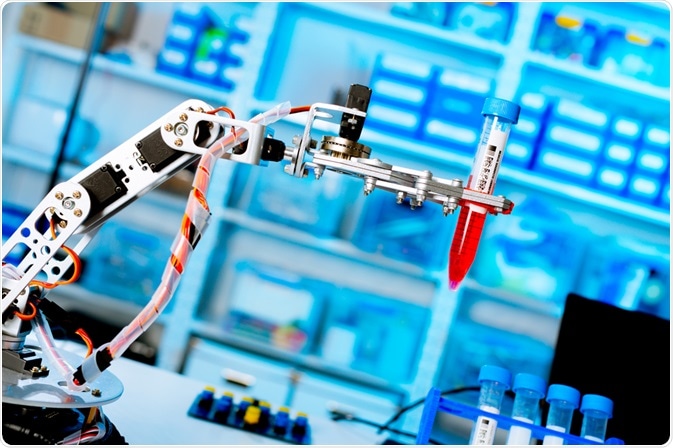The growing market of laboratory robotics
Laboratory robotics refers to the use of a variety of robots, all specifically designed to serve a certain purpose, to either automate a task or assist the human technician/staff in completing a task.
Laboratory robotics have become established in several industries, with many advancements over the past few decades.

Image Credit: Science Photo/Shutterstock.com
Sectors such as manufacturing and automotive have greatly benefited from the use of industry-specific robotics.
However, the medical sector and pharmaceuticals may have benefited the most. For over 30 years, laboratory robots have been designed for and implemented in biological and chemical labs within the medical industry.
In the 1980s, the first robot was utilized to assist in surgery, with the programmable universal machine for assembly (PUMA) in urology surgery. There have been many developments since the 1980s, with multiple new robots created in aid of a myriad of tasks.
One of the most advanced and widely used of these innovations is the da Vinci robot, which uses a minimally invasive approach to facilitate surgery, inserting a tiny 3D camera and miniature surgical instruments inside the patient through small incisions, allowing the surgeon can operate remotely.
Recent reports have revealed that the laboratory robotics market has shown trends that the purchase and use of laboratory robotics are increasing throughout sectors, with the cost of laboratory robotics decreasing.
An introduction to lab automation
The advantages of using laboratory robots
Laboratory robotics provide a variety of advantages to the user and the medical field. Below we discuss each benefit.
Firstly, laboratory robotics can work in environments that are not safe for humans, which could be anything ranging from working with dangerous chemicals to withstanding harsh environmental conditions.
This allows for experiments and works to be conducted that may not have been possible without robotics that would have taken significantly more time or posed danger to the workers.
A major advantage of laboratory robotics is greatly enhanced productivity. This is achieved in several ways.
As mentioned above, the robots can easily work with hazardous chemicals.
Tasks undertaken by humans involving hazardous chemicals require numerous safety protocols that can slow down the task, whereas robots do not require the same precautions.
Further advantages of robotics are the lack of fatigue in comparison to humans and robots are not subject to human error.
Robots possess the ability to continue work at the same speed and consistency, without the need for rest or affected by tiredness or boredom if a task is repetitive. Robots are quicker thus enhancing productivity by the ability to conduct the same tasks as a human in a shorter period.
Finally, productivity is further enhanced as robots can take over tasks from humans, which can be redeployed to other areas of the business. There is less waste produced by robots in comparison to humans due to more efficient material use.
Whilst upfront costs of robots may be expensive, over time they save money by reducing waste, enhancing productivity, and reducing the reliance on humans (who require a salary).
It is expected that the use of laboratory robotics will continue to increase into the future and that innovations will continue to be made to address different needs, growing the capabilities of laboratory robotics.
References:
- Isenhour, T. L., & Marshall, J. C. (1990). Laboratory robotics and artificial intelligence. Clinical chemistry, 36(9), 1561-1566.
- Keating, P., Limoges, C., & Cambrosio, A. (1999). The automated laboratory. The practices of human genetics (pp. 125-142). Springer, Dordrecht.
- Linder, M. (1990). Laboratory Automation and Robotics-Quo Vadis?. Data Handling in Science and Technology (Vol. 6, pp. 273-284). Elsevier.
- Peláez, A. L., & Kyriakou, D. (2008). Robots, genes, and bytes: technology development and social changes towards the year 2020. Technological Forecasting and Social Change, 75(8), 1176-1201.
- Sparkes, A., Aubrey, W., Byrne, E., Clare, A., Khan, M., Liakata, M., Markham, M., Rowland, J., Soldatova, L., Whelan, K., Young, M. and King, R. (2010). Towards Robot Scientists for autonomous scientific discovery. Automated Experimentation, 2(1), p.1.
Further Reading
Last Updated: Nov 4, 2024